PEP六年级英语Unit1whoisyounger1
- 格式:ppt
- 大小:2.49 MB
- 文档页数:30
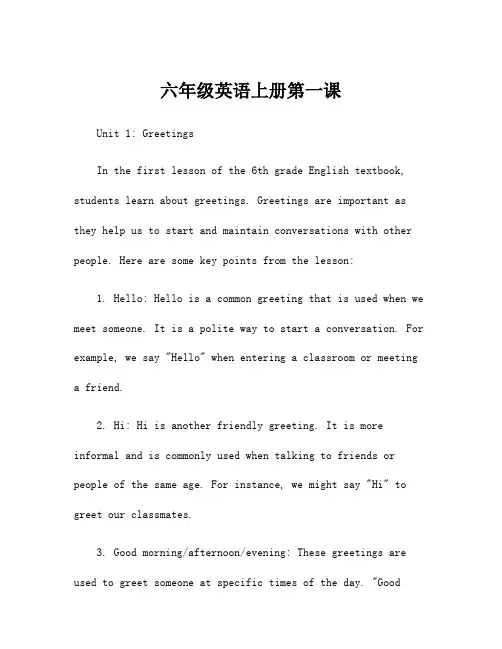
六年级英语上册第一课Unit 1: GreetingsIn the first lesson of the 6th grade English textbook, students learn about greetings. Greetings are important as they help us to start and maintain conversations with other people. Here are some key points from the lesson:1. Hello: Hello is a common greeting that is used when we meet someone. It is a polite way to start a conversation. For example, we say "Hello" when entering a classroom or meetinga friend.2. Hi: Hi is another friendly greeting. It is more informal and is commonly used when talking to friends or people of the same age. For instance, we might say "Hi" to greet our classmates.3. Good morning/afternoon/evening: These greetings are used to greet someone at specific times of the day. "Goodmorning" is used in the morning until around noon. "Good afternoon" is used from noon until evening, and "Good evening" is used after dark.4. How are you?: This is a common way to ask someone about their well-being. It's a polite way to show interest in the other person. When someone asks, "How are you?", we can reply with phrases like, "I'm fine, thank you" or "I'm good, and you?"5. Goodbye: Goodbye is used when we want to end a conversation or to say farewell. It's a polite way to end a conversation. For example, we say "Goodbye" to our friends when leaving school.6. See you later: This is an informal way to say goodbye when you expect to see the person again soon. It expresses the hope to meet again in the near future. For instance, we might say "See you later" to our classmates at the end of the school day.Remember, using appropriate greetings is an essential part of communication and helps us to build relationships with others. By using greetings, we show respect and kindness to those we meet. Practicing these greetings will make interactions more pleasant and enjoyable. So, let's greet others with a smile and start meaningful conversations!。
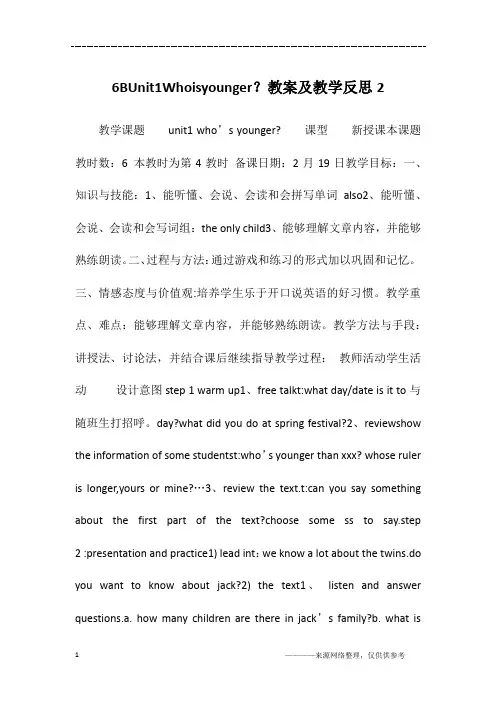
6BUnit1Whoisyounger?教案及教学反思2教学课题unit1 who’s younger?课型新授课本课题教时数:6 本教时为第4教时备课日期:2月19日教学目标:一、知识与技能:1、能听懂、会说、会读和会拼写单词also2、能听懂、会说、会读和会写词组:the only child3、能够理解文章内容,并能够熟练朗读。
二、过程与方法:通过游戏和练习的形式加以巩固和记忆。
三、情感态度与价值观:培养学生乐于开口说英语的好习惯。
教学重点、难点:能够理解文章内容,并能够熟练朗读。
教学方法与手段:讲授法、讨论法,并结合课后继续指导教学过程:教师活动学生活动设计意图step 1 warm up1、free talkt:what day/date is it to与随班生打招呼。
day?what did you do at spring festival?2、reviewshow the information of some studentst:who’s younger than xxx? whose ruler is longer,yours or mine?…3、review the text.t:can you say something about the first part of the text?choose some ss to say.step 2 :presentation and practice1) lead int:we know a lot about the twins.do you want to know about jack?2) the text1、listen and answer questions.a. how many children are there in jack’s family?b. what isjimmy?c. how old is jimmy?the answers:a. only one.jack is the only child in his family.b. jimmy is jack’s dog.c. jimmy is one year younger than jack.teach: the only child one year younger than …渗透:two years younger/older than…t:i’m 14 years older than you.can you make sentences like this?3) read the text after the tape. 指导随班生朗读对话。
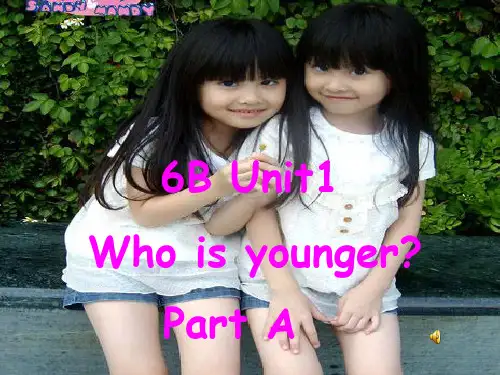
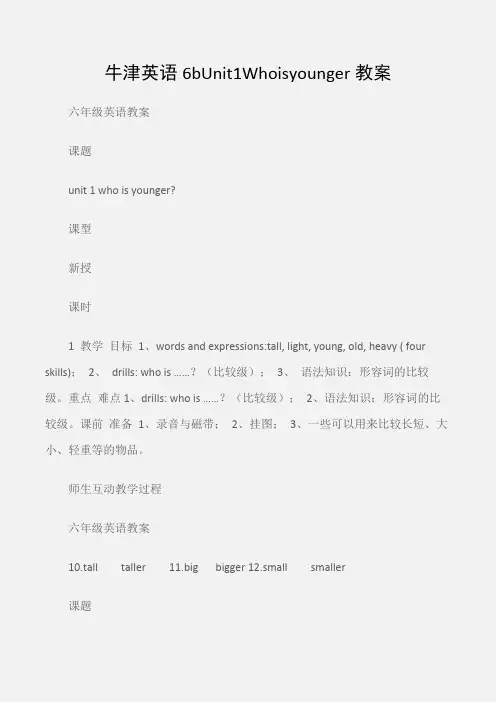
牛津英语6bUnit1Whoisyounger教案六年级英语教案课题unit 1 who is younger?课型新授课时1 教学目标1、words and expressions:tall, light, young, old, heavy ( four skills);2、drills: who is ……?(比较级);3、语法知识:形容词的比较级。
重点难点1、drills: who is ……?(比较级);2、语法知识:形容词的比较级。
课前准备1、录音与磁带;2、挂图;3、一些可以用来比较长短、大小、轻重等的物品。
师生互动教学过程六年级英语教案10.tall taller 11.big bigger 12.small smaller课题unit 1 who is younger?课型新授课时2教学内容pat c and e教学目标1.words: than , centimetre ; 2.drills: who’s taller than david? ; gan shan is taller than david.(四会) whose school bag is heavier , yours or mine?(三会)。
重点难点1.能用句型who’s taller than david? ; gan shan ix taller than david. whose school bag is heavier , yours or mine?等含有形容词比较级的句型进行交际;2.理解并能正确的运用形容词的比较级。
课前准备1、录音与磁带;2、挂图;3、一些可以用来比较长短、大小、轻重等的物品。
师生互动教学过程教学环节教师活动学生活动a revisions 1.利用实物挂图等在句型中复习12组单词;2.在复习中自然导出句型:……than……. 3.teach ‘than’b presentations 1.ask some students to stand up.who’s taller than xxx? 2.pair work: who’s taller than……? 3.who’s taller ,your father or your mother? 用older, younger, shorter, stronger, fatter, thinner,等进行练习;c practise 1.利用学生的实物进行问答:whose ruler is longer, yours or mine?2.group work:whose is ……?3.free talk:whose is……? 1..say:xxx’s ……is …….than b.2.say: shang hai is bigger than nanjing. changjiang is longer than huanghe.a elephant is bigger than a bear. a panda is fatter than a horse.d read and act 1.let’s play football. who will be the goalkeeper? why? 2.引导学生交流。
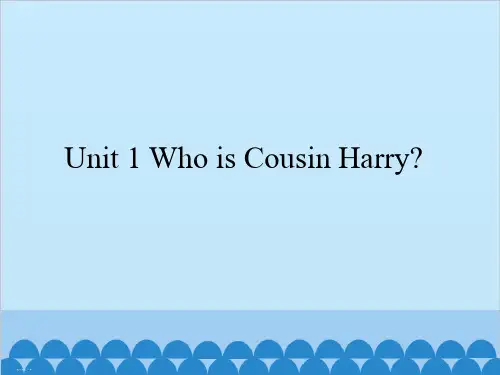
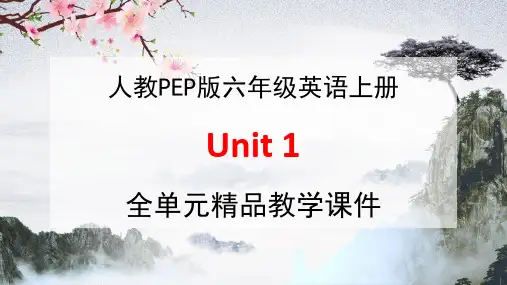
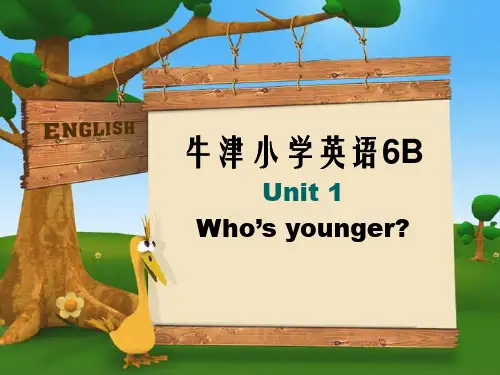

6BUnit1Whoisyounger?教案及教学反思1六年级英语教案
教学课题
unit1 who’s younger?
课型
新授课本课题教时数:6 本教时为第1教时备课日期:2月15日教学目标:一、知识与技能:1、能听懂、会说、会读和会拼写单词
older,young,younger,taller,fatter,thinner,shorter,strong,stronger.
2、能听懂、会说、会读和会写句型who’s taller than david?gao shan is taller than david.二、过程与方法:通过学习单词的比较级,学生能够比较人物或者物体的高矮、长短等三、情感态度与价值观:培养学生实际运用英语进行交流的能力和乐于于人交流、合作的个性。
教学重点、难点:1、能听懂、会说、会读和会拼写单词
older,young,younger,taller,fatter,thinner,shorter,strong,stronger.
2、能听懂、会说、会读和会写句型who’s taller than david?gao shan is taller than david.教学方法与手段:多媒体课件,单词及句型卡片, 情景教学法、交际法教学过程:教师活动学生活动。
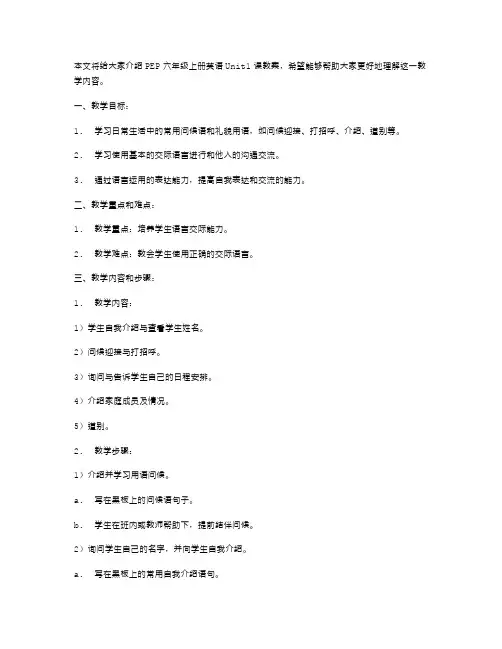
本文将给大家介绍PEP六年级上册英语Unit1课教案,希望能够帮助大家更好地理解这一教学内容。
一、教学目标:1.学习日常生活中的常用问候语和礼貌用语,如问候迎接、打招呼、介绍、道别等。
2.学习使用基本的交际语言进行和他人的沟通交流。
3.通过语言运用的表达能力,提高自我表达和交流的能力。
二、教学重点和难点:1.教学重点:培养学生语言交际能力。
2.教学难点:教会学生使用正确的交际语言。
三、教学内容和步骤:1.教学内容:1)学生自我介绍与查看学生姓名。
2)问候迎接与打招呼。
3)询问与告诉学生自己的日程安排。
4)介绍家庭成员及情况。
5)道别。
2.教学步骤:1)介绍并学习用语问候。
a.写在黑板上的问候语句子。
b.学生在班内或教师帮助下,提前结伴问候。
2)询问学生自己的名字,并向学生自我介绍。
a.写在黑板上的常用自我介绍语句。
b.学生在教师及其他部分学生的帮助下,逐个介绍自己姓名、年龄、住址、家庭成员等信息,并与其他同学交流。
3)介绍别人与打招呼。
a.写在黑板上的常用打招呼、介绍语句。
b.学生模仿教师的精神,模仿教师与其他学生、学生之间的交流,并进行包含“这是…”之类的介绍。
4)询问与告诉学生日程安排:a.写在黑板上的常用交流语言。
b.学生在教师的提示、他人的帮助下,询问课程安排,交流课业情况,寻求其他的帮助等。
5)介绍家庭成员及情况:a.写在黑板上的常用交流语言。
b.学生根据幻灯片中的模板进行介绍,描述家庭成员、生活环境、家庭状况等,在语言表达上发现问题并互相帮助。
6)道别:a.写在黑板上的常用道别语言。
b.学生在教师的提示、其他学生的帮助下,说出道别语言。
四、教学方法:1.情境教学法:通过让学生模仿教师的表情言行,学生能够更好地理解课上的内容。
2.任务驱动教学法:通过教师布置任务和组织学生小组交流合作,集体讨论、提问、引导学生的交流话题。
任务要求通过组织实现。
三、练习方法:写作练习:写一篇英语小短文,通过情境描述其语言技能简介,也可以选择模拟对话以提高其口头表达能力。

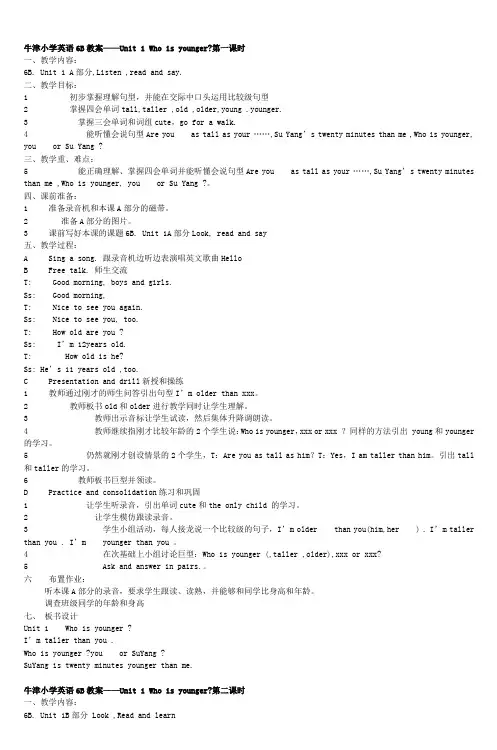
牛津小学英语6B教案——Unit 1 Who is younger?第一课时一、教学内容:6B. Unit 1 A部分,Listen ,read and say.二、教学目标:1 初步掌握理解句型,并能在交际中口头运用比较级句型2 掌握四会单词tall,taller ,old ,older,young .younger.3 掌握三会单词和词组cute,go for a walk.4 能听懂会说句型Are you as tall as your ……,Su Yang’s twenty minutes than me ,Who is younger, you or Su Yang ?三、教学重、难点:5 能正确理解、掌握四会单词并能听懂会说句型Are you as tall as your ……,Su Yang’s twenty minutes than me ,Who is younger, you or Su Yang ?。
四、课前准备:1 准备录音机和本课A部分的磁带。
2 准备A部分的图片。
3 课前写好本课的课题6B. Unit 1A部分Look, read and say五、教学过程:A Sing a song. 跟录音机边听边表演唱英文歌曲HelloB Free talk. 师生交流T: Good morning, boys and girls.Ss: Good morning,T: Nice to see you again.Ss: Nice to see you, too.T: How old are you ?Ss: I’m 12years old.T: How old is he?Ss: He’s 11 years old ,too.C Presentation and drill新授和操练1 教师通过刚才的师生问答引出句型I’m older than xxx。
2 教师板书old和older进行教学同时让学生理解。
六年级上册英语第一课Hello, everyone! My name is Mike. I'm in Grade 6. I want to tell you something about my family.This is my father. He is a tall and strong man. He works as a doctor in a big hospital. He is very kind and always helps others. He loves me and my mom very much.This is my mother. She is a beautiful woman. She is a teacher in a primary school. She is very patient and always helps me with my homework. She cooks delicious food for me every day.I have a little sister. Her name is Lily. She is onlyfive years old. She is very cute and likes to play with me. I always take care of her and play games with her after school.We love each other and always help each other. We often have meals together and talk about our day. My family is very important to me and I love them very much.I also have a pet. It's a small yellow dog named Max. He is very active and loves to play with me in the park.I am very happy to have such a warm and happy family. I will work hard and make my family proud of me. Thank you for listening to my introduction.。
小学英语六年级Unit1_—_学年度第一学期单元检测小学PEP英语六年级上册 Unit 1校别: 班别: 姓名: 评价:JKL一.听音,选出你听到的单词.( ) 1. A. pig B.big C.ship D.it( ) 2. A. peak B.beat C.bear D.pear( ) 3. A. team B.deal C.near D.tea( ) 4.A. thinB.dish C.si_ D.ten( ) 5. A. stop B.shop C.ship D.sheep二.听音,根据图意选择各组中正确的说法.by bike bysubway on footby bus by train1 ( )2 ( )3 ( )4 ( ) 5( )三.听音,填充对话所缺单词.Luke: Howdo you go to school, Mike?Mike: Iusually go to school . Sometimes I go .How do you go to school?Luke: Iwant to go .How can I get there?Mike: It’seasy. Walk to the . Turn right. You can see it.Luke: Ok.Thank you very much.Mike: You’rewelcome.四.听音,完成下列的调查表.NamePlaceVehicleLi YanHe PingMiss Liu五.听音,根据听到的内容给下面各组交通灯中相应的灯涂上正确的颜色.1 2 3六.读下面各组单词,判断下面各组单词中划线部分字母的读音是否相同.( ) 1. A. leaf B.please C.tea D.tree( ) 2. A. pig B.time C.fifth D.music( ) 3. A. spring B.swing C.thin D.dish( ) 4. A. green B.eat C.peach D.three( ) 5. A. in B. it C. is D.hi.看图,写单词.公共汽车火车飞机自行车交通灯八.判断下面各句说法的正误.( ) 1. Usually I goto the USA by subway.( ) 2. In China,drivers drive on the right side of the road.( ) 3. In China, thegreen light is on the left of the traffic lights.( ) 4. Usually I goto school on foot, because it’s fast.( ) 5. In fall, it’ssunny and cool.九.按要求完成下面的句子.1.I go to the park on foot. (就划线部分提问)2. Usually I go toschool by train, because my home is near. (改错)3. my,office, near, is, the, post, home (连词成句)4. You can goon foot, if you like. It’s not far. (译成中文)5. How do yougo to school? (根据你自己的实际情况回答)十.阅读下面一段短文,根据短文内容判断句子的正(T)误(F).Thetwins have a big room. There are two beds, a desk and two chairs in it. Thedoor of the room is green. There are four windows in it, too. There’s a clockand some nice pictures on the wall. The clock is old. It’s seven thirty in theevening. Lily is on the chair near the desk. Lucy isn’t in the room.( )1. Lily and Lucy are twins.( )2. The door of Lucy’s room is green.( )3. Now it’s seven o’clock in the evening.( )4. Lily is in the room now.( )5. The door has four windows.六年级上册Unit 1 单元检测题听力材料一.听音,选出你听到的单词.1. pig2.pear 3.tea 4.dish 5.shop二.听音,根据图意选择各组中正确的说法.1.A. I go to school by bike.B. I go to school by bus.C. I go to school by ta_i.2. A. I goto school by bus.B.I go to school by ship.C.I go to school by train.3. A. I goto school by bike.B.I go to school on foot.C.I go to school by subway.4. A.I go to school by car.B.I go to school by train.C.I go to school by bus.5. A. I goto school by subway.B.I go to school on foot.C.I go to school by plane.三.听音,填充对话所缺单词.Luke: Howdo you go go school, Mike?Mike: Iuaually go to school by bike. Sometimes I go on foot. How do you go to school?Luke: Iwant to go on foot. How can I get there?Mike: It’seasy. Walk to the traffic lights. Turn right. You can see it.Luke: Ok.Thank you very much.Mike: You’rewelcome.四.听音,完成下列的调查表.1.A: Hello! Li Yan. October 1st is National Day. Where would you like to go?B: I’d like to go toZhaoqing.A: How do you go there?B: I go by bus.2.A: Hi! He Ping. October 1st is National Day. Where would you like to go?B: I’d like to go toGuangzhou.A: How do you go there?B: I go by ship.3.A: Hello! Miss Liu. October 1st is National Day.Where would you like to go?B: I’d like to go toBeijing.A: How do you go there?B: I go by plane.五.听音,根据听到的内容给下面各组交通灯中相应的灯涂上正确的颜色.1.Look at the traffic lights. The middle light is yellow, we have to wait.2.The light is red. Stop!3.Look! It’s green on the left. We can go!。